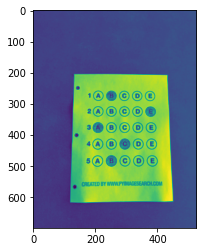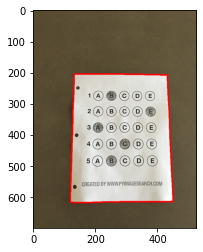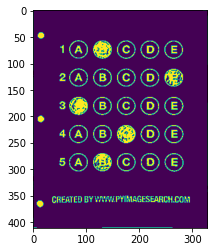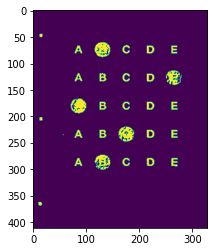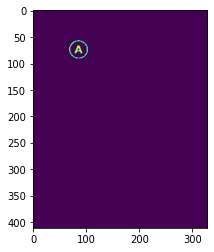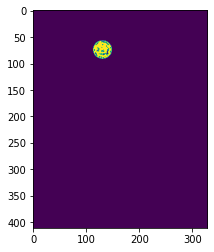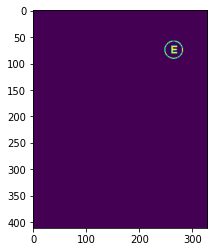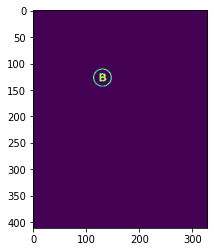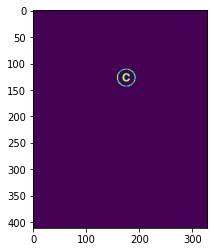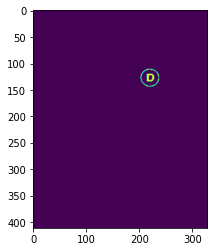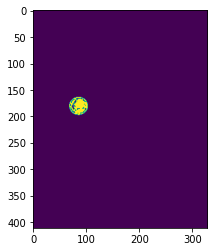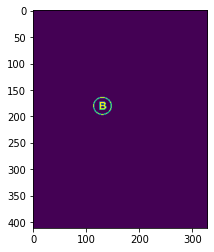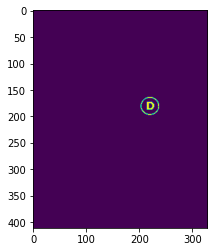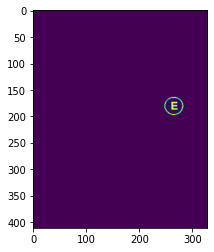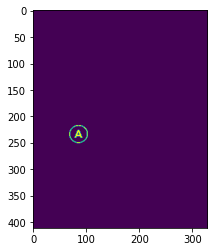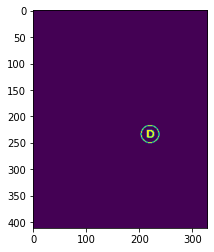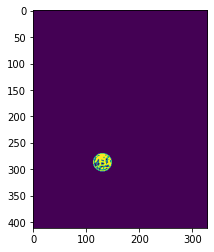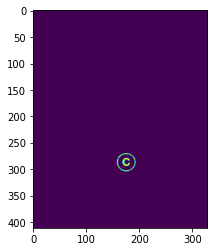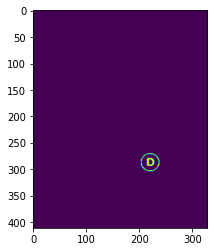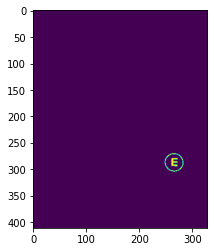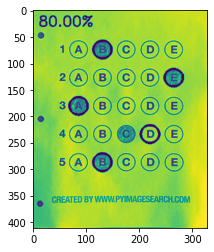import numpy as np
import argparse
import imutils
import cv2
import matplotlib. pyplot as plt
ANSWER_KEY = {
0 : 1 , 1 : 4 , 2 : 0 , 3 : 3 , 4 : 1 }
def order_points ( pts) :
rect = np. zeros( ( 4 , 2 ) , dtype = "float32" )
s = pts. sum ( axis = 1 )
rect[ 0 ] = pts[ np. argmin( s) ]
rect[ 2 ] = pts[ np. argmax( s) ]
diff = np. diff( pts, axis = 1 )
rect[ 1 ] = pts[ np. argmin( diff) ]
rect[ 3 ] = pts[ np. argmax( diff) ]
return rect
def four_point_transform ( image, pts) :
rect = order_points( pts)
( tl, tr, br, bl) = rect
widthA = np. sqrt( ( ( br[ 0 ] - bl[ 0 ] ) ** 2 ) + ( ( br[ 1 ] - bl[ 1 ] ) ** 2 ) )
widthB = np. sqrt( ( ( tr[ 0 ] - tl[ 0 ] ) ** 2 ) + ( ( tr[ 1 ] - tl[ 1 ] ) ** 2 ) )
maxWidth = max ( int ( widthA) , int ( widthB) )
heightA = np. sqrt( ( ( tr[ 0 ] - br[ 0 ] ) ** 2 ) + ( ( tr[ 1 ] - br[ 1 ] ) ** 2 ) )
heightB = np. sqrt( ( ( tl[ 0 ] - bl[ 0 ] ) ** 2 ) + ( ( tl[ 1 ] - bl[ 1 ] ) ** 2 ) )
maxHeight = max ( int ( heightA) , int ( heightB) )
dst = np. array( [
[ 0 , 0 ] ,
[ maxWidth - 1 , 0 ] ,
[ maxWidth - 1 , maxHeight - 1 ] ,
[ 0 , maxHeight - 1 ] ] , dtype = "float32" )
M = cv2. getPerspectiveTransform( rect, dst)
warped = cv2. warpPerspective( image, M, ( maxWidth, maxHeight) )
return warped
def sort_contours ( cnts, method= "left-to-right" ) :
reverse = False
i = 0
if method == "right-to-left" or method == "bottom-to-top" :
reverse = True
if method == "top-to-bottom" or method == "bottom-to-top" :
i = 1
boundingBoxes = [ cv2. boundingRect( c) for c in cnts]
( cnts, boundingBoxes) = zip ( * sorted ( zip ( cnts, boundingBoxes) ,
key= lambda b: b[ 1 ] [ i] , reverse= reverse) )
return cnts, boundingBoxes
def cv_show ( name, img) :
b, g, r = cv2. split( img)
img_rgb = cv2. merge( ( r, g, b) )
plt. imshow( img_rgb)
plt. show( )
def cv_show1 ( name, img) :
plt. imshow( img)
plt. show( )
cv2. imshow( name, img)
cv2. waitKey( )
cv2. destroyAllWindows( )
image = cv2. imread( "./images/test_01.png" )
contours_img = image. copy( )
gray = cv2. cvtColor( image, cv2. COLOR_BGR2GRAY)
blurred = cv2. GaussianBlur( gray, ( 5 , 5 ) , 0 )
cv_show1( 'blurred' , blurred)
edged = cv2. Canny( blurred, 75 , 200 )
cv_show1( 'edged' , edged)
cnts = cv2. findContours( edged. copy( ) , cv2. RETR_EXTERNAL,
cv2. CHAIN_APPROX_SIMPLE) [ 1 ]
cv2. drawContours( contours_img, cnts, - 1 , ( 0 , 0 , 255 ) , 3 )
cv_show( 'contours_img' , contours_img)
docCnt = None
if len ( cnts) > 0 :
cnts = sorted ( cnts, key= cv2. contourArea, reverse= True )
for c in cnts:
peri = cv2. arcLength( c, True )
approx = cv2. approxPolyDP( c, 0.02 * peri, True )
if len ( approx) == 4 :
docCnt = approx
break
warped = four_point_transform( gray, docCnt. reshape( 4 , 2 ) )
cv_show1( 'warped' , warped)
thresh = cv2. threshold( warped, 0 , 255 ,
cv2. THRESH_BINARY_INV | cv2. THRESH_OTSU) [ 1 ]
thresh_Contours = thresh. copy( )
cv_show1( 'thresh_Contours' , thresh_Contours)
cnts = cv2. findContours( thresh. copy( ) , cv2. RETR_EXTERNAL,
cv2. CHAIN_APPROX_SIMPLE) [ 1 ]
cv2. drawContours( thresh_Contours, cnts, - 1 , ( 0 , 0 , 255 ) , 3 )
print ( len ( cnts) )
cv_show1( 'thresh_Contours' , thresh_Contours)
questionCnts = [ ]
82
for c in cnts:
( x, y, w, h) = cv2. boundingRect( c)
ar = w / float ( h)
if w >= 20 and h >= 20 and ar >= 0.9 and ar <= 1.1 :
questionCnts. append( c)
questionCnts = sort_contours( questionCnts,
method= "top-to-bottom" ) [ 0 ]
correct = 0
for ( q, i) in enumerate ( np. arange( 0 , len ( questionCnts) , 5 ) ) :
cnts = sort_contours( questionCnts[ i: i + 5 ] ) [ 0 ]
bubbled = None
for ( j, c) in enumerate ( cnts) :
mask = np. zeros( thresh. shape, dtype= "uint8" )
cv2. drawContours( mask, [ c] , - 1 , 255 , - 1 )
mask = cv2. bitwise_and( thresh, thresh, mask= mask)
total = cv2. countNonZero( mask)
cv_show1( 'mask' , mask)
if bubbled is None or total > bubbled[ 0 ] :
bubbled = ( total, j)
color = ( 0 , 0 , 255 )
k = ANSWER_KEY[ q]
if k == bubbled[ 1 ] :
color = ( 0 , 255 , 0 )
correct += 1
cv2. drawContours( warped, [ cnts[ k] ] , - 1 , color, 3 )
score = ( correct / 5.0 ) * 100
print ( "[INFO] score: {:.2f}%" . format ( score) )
cv2. putText( warped, "{:.2f}%" . format ( score) , ( 10 , 30 ) ,
cv2. FONT_HERSHEY_SIMPLEX, 0.9 , ( 0 , 0 , 255 ) , 2 )
cv_show( "Original" , image)
cv_show1( "Exam" , warped)
[INFO] score: 80.00%
1.【2021B站最好的OpenCV课程推荐】OpenCV从入门到实战 全套课程
